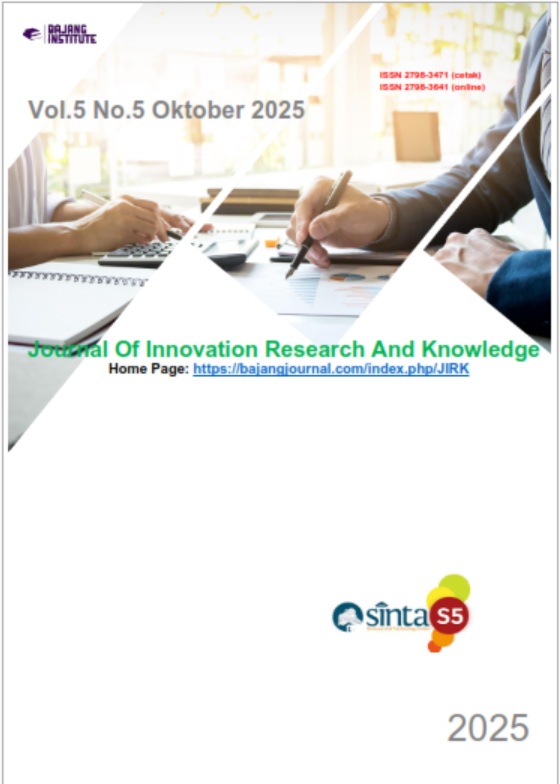GAYA KEPEMIMPINAN DEMOKRATIS DAN WORK ENGAGEMENT PADA KARYAWAN DI PT X
DOI:
https://doi.org/10.53625/jirk.v5i5.11483Keywords:
Democratic Leadership Style, Work Engagement, EmployeesAbstract
This study is motivated by the importance of work engagement in improving employees’ productivity and work quality. One of the factors assumed to be related to work engagement is the use of a democratic leadership style. The purpose of this research is to determine the relationship between democratic leadership style and work engagement among employees of PT X. The research method used was quantitative with a correlational approach. The sample consisted of 141 employees selected using the total sampling technique. The instruments used were the Leadership Democratic Style Scale (LDSS) and the Utrecht Work Engagement Scale (UWES). Data analysis was conducted using the Pearson correlation test with the assistance of Jamovi software. The results showed a positive and significant relationship between democratic leadership style and work engagement. Thus, it can be concluded that the higher the application of the democratic leadership style, the higher the employees’ work engagement. These findings highlight the importance of participatory leadership in enhancing work engagement and productivity in the seafood processing and export sector
References
Azwar, S. (2009). Metode penelitian. Pustaka Belajar.
Bakker, A. B., & Leiter, M. P. (2010). Work engagement: A handbook of essential theory and research. Psychology Press.
Bove, C. L. (1995). Management. McGraw-Hill.
Chegeni, F. F., Abbasi, M., & Ghadampour, E. (2024). The causal relationship between authentic leadership style, school culture, and proactive personality with teachers’ job engagement: The mediating role of psychological contract. Journal of Applied Educational Leadership, 16(4). https://doi.org/10.22098/AEL.2023.12411.1234
Creswell, J. W., & Creswell, J. D. (2017). Research design: Qualitative, quantitative, and mixed methods approaches. Sage Publications.
Decuypere, A., & Schaufeli, W. (2020). Leadership and work engagement: Exploring explanatory mechanisms. German Journal of Human Resource Management, 34(1), 69–95. https://doi.org/10.1177/2397002219892197
Erwina, E. (2020). Analisis employee engagement melalui dimensi vigor, dedication dan absorption pada PT Sumber Graha Sejahtera di Kabupaten Luwu. JEMMA (Journal of Economic, Management and Accounting), 3(2), 173–180. https://doi.org/10.35914/jemma.v3i2.441
Gunawan, A., & Hartati, L. (2025). Strategi kepemimpinan dalam meningkatkan keterlibatan karyawan pada organisasi multinasional. Jurnal Ekonomi Utama, 4(1), 65–88. https://doi.org/10.55903/juria.v4i1.243
Hadi, S. (2000). Metodologi research. Fakultas Psikologi UGM.
Imran, M., Li, J., Bano, S., & Rashid, W. (2025). Impact of democratic leadership on employee innovative behavior with mediating role of psychological safety and creative potential. Sustainability, 17(5), 1879. https://doi.org/10.3390/su17051879
Jerris, L. A. (1999). Human resources management for hospitality. Prentice Hall.
Kahn, W. A. (1990). Psychological conditions of personal engagement and disengagement at work. Academy of Management Journal, 33(4), 692–724. https://doi.org/10.5465/256287
Liu, J., Cho, S., & Putra, E. D. (2017). The moderating effect of self-efficacy and gender on work engagement for restaurant employees in the United States. International Journal of Contemporary Hospitality Management, 29(1), 624–642. https://doi.org/10.1108/IJCHM-10-2015-0539
Lockwood, N. R. (2007). Leveraging employee engagement for competitive advantage: HR’s strategic role. SHRM Research Quarterly.
Noviantoro, D., Andriyani, I., & Sakinah, S. (2021). Pengaruh work engagement, iklim organisasi dan kompensasi terhadap motivasi berprestasi pada sales advisor PT. Serasi Mitra Mobil Palembang. EKOMBIS REVIEW: Jurnal Ilmiah Ekonomi dan Bisnis, 9(2), 299–312. https://doi.org/10.37676/ekombis.v9i2.1390
Putri, H. N., Daud, I., Rosnani, T., Fahruna, Y., & Shalahuddin, A. (2023). Servant leadership on work engagement: Mediating job satisfaction and trust in leader. Jurnal Informatika Ekonomi Bisnis, 5(4), 1248–1252. https://doi.org/10.37034/infeb.v5i4.742
Robbins, S. P., & Coulter, M. (2002). Manajemen (Edisi ke-7, Jilid 2, Terj. Sarwiji & Hermaya). PT Indeks Kelompok Gramedia.
Salliyuana, C., & Hidayat, M. R. (2024). Employee engagement, beban kerja, dan kepuasan kerja terhadap kinerja karyawan. Jurnal Alwatzikhoebillah: Kajian Islam, Pendidikan, Ekonomi, Humaniora, 10(1), 159–172. https://doi.org/10.37567/alwatzikhoebillah.v10i1.2487
Saks, A. M. (2006). Antecedents and consequences of employee engagement. Journal of Managerial Psychology, 21(7), 600–619. https://doi.org/10.1108/02683940610690169
Santoso, A. (2010). Studi deskriptif effect size penelitian-penelitian di Fakultas Psikologi Universitas Sanata Dharma. Jurnal Penelitian, 15(1).
Schaufeli, W. B., & Bakker, A. B. (2003). Utrecht work engagement scale: Preliminary manual. Occupational Health Psychology Unit, Utrecht University.
Schaufeli, W. B., & Bakker, A. B. (2004). UWES: Utrecht work engagement scale preliminary manual. Occupational Health Psychology Unit, Utrecht University.
Schaufeli, W. (2012). Work engagement: What do we know and where do we go? Romanian Journal of Applied Psychology, 14(1), 3–10.
Sembiring, I. (2023). Hubungan antara gaya kepemimpinan demokratis dengan work engagement.
Sugiyono. (2017). Metode penelitian kuantitatif, kualitatif, dan R&D. Alfabeta.
Sukoco, I., Fu’adah, D. N., & Muttaqin, Z. (2020). Work engagement of millennial generation employees at PT X Bandung. Jurnal Pemikiran dan Penelitian Administrasi Bisnis dan Kewirausahaan, 5(3), 263–281. https://doi.org/10.24198/adbispreneur.v5i3.29953.
Ulum, M., Mansur, M., & Rahman, F. (2020). Pengaruh human capital dan employee engagement terhadap produktivitas kerja karyawan (Studi kasus pada Bea Cukai Kanwil Jatim II). E-JRM: Elektronik Jurnal Riset Manajemen, 9(12).













